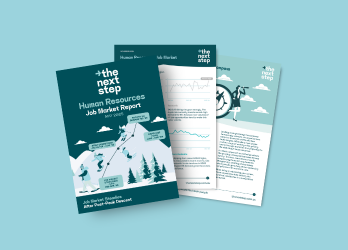Bounce Back & Move Forward: Resilience for HR

It's been a long, stressful year and people everywhere are feeling drained. This relentless pressure has derailed countless plans and put the HR community at risk of burn-out.
Resilience is intrinsic within many HR professionals, but there are techniques that can help you raise your resilience levels and boost your inner-strength. Read on to learn more.
Why is resilience important for HR?
When people problems crop up, HR professionals must put their own plans aside and dig deep to help others. The daily job is enough to wear us down, but throw in pandemic-related challenges and many can be pushed to breaking point.
Having the capacity to deal with problems and then bounce back again is critical for HR professionals. Wholistic resilience can help you cope with pressure and empower you to take ownership to move forward with your strategic plans.
Your resilience levels aren’t fixed. They can bounce around and change… sometimes at a moment’s notice. A poor night’s sleep or an unexpected spanner in the works can throw you off-balance. On the plus side, however, there are effective ways to build your resilience.
Bounce back quickly
In a recent Next Step webinar 'BEing Resilient' People and Culture Strategist Vanessa Porter defined resilience as “Having the inner resources to bend, flex, and come back to normal in the face of adversity without being overly disrupted from your focus.”
It’s natural to have strong emotions, but they aren't meant to dominate. You need to “ask them to leave” so that you can return to normal. Remaining too long in a state of overwhelm can have damaging effects. The faster it is for you to ‘bounce back’, the easier it is to move forward with your plans.
Allowing stress to build over the day can negatively impact you, your colleagues, your productivity, and sleep patterns.“If we have a poor, disturbed sleep during the night, we don't recover to our baseline, and the next morning we are already showing early warning signs of returning to a state of overwhelm,” says Stress Scientist Chris Wilson. The bandwidth between our base line and high stress state can be increased by knowing and recognising your body's internal early warning signs.
Holistic Resilience
The traditional view of resilience is relatively narrow, centering on mental toughness, but HR people can benefit from taking a more holistic approach. Consider how you feel when stressed and overwhelmed. Often there are physical and emotional aspects too... you might have tension headaches, get snappy or experience chocolate cravings.
Pay attention to your body’s ‘early warning signs’. When you feel yourself entering a high-stress state make a conscious effort to downregulate and come back to a healthy space. If you ignore the signs, you may reach a state of overwhelm, which begins to deplete your natural resilience. “Raise your resilience by raising the bandwidth between the [stress] baseline and the early warning signs,” explains Chris Wilson - Stress Scientist.
The good news is our body’s cells are able to adapt to cope with the stress hormone cortisol, so that we can build inner-strength over time. “Resilience is like a muscle,” Chris Wilson explains, “The more you practice using it, the stronger it gets.”
Techniques for building resilience
Learn to tolerate more stress and build resilience by working on three key areas:
Physical – Pay attention to your body’s early warning signs. Take active measures to reduce stress to help you get a good night’s sleep. Poor sleep affects our resilience levels.
Emotional – Allocate time in your day to reset and recover after periods of high-stress. This could be as simple as taking a walk, finding time to eat properly, or try meditating. If your brain doesn’t downregulate your resilience will suffer. Shine a spotlight on positive thoughts. Consider using a gratitude diary. Find things that re-energise and engage you.
Mental – Instead of endless worry, write your problems down on post-it notes. Prioritise those you can do something about and take practical steps. For bigger problems try scheduling official ‘worry time’. Limit how long you will worry for, then let the worry go at the end.
“ I schedule worry time now... I answer these questions: What am I worried about? What's the worst thing can happen? Is there something I can do? “ - Vanessa Porter.
Resilience & recruitment
Resilience for HR job-seekers
Searching for a new HR job can be demoralising. Resilience is needed to cope with ongoing applications and knock-backs. You can’t control which organisations are hiring, or who you are going up against. Worrying about this causes unnecessary stress and dents your resilience.
Regain control of the process by keeping your LinkedIn profile looking smart and fresh and your resume up-to-date. Research tips for interviews and seek constructive feedback about your interview performance. Try to ascertain what differentiates you in a hiring manager’s eyes and understand any gaps. Invest in professional development, ongoing learning or reading to help address these issues. Practical measures will help you feel in control and keep your resilience levels high.
Resilience for hiring managers
With the Great Resignation expected to hit Australian shores in 2022 hiring manager may find their resilience levels are further-tested. There is no way to control what talent is available in the market, but you can control the quality and quantity of HR people you have access to.
A exclusive relationship with a quality recruitment consultant gives hiring managers quality service and peace of mind. Rather than blindly posting job ads and hoping for the best, The Next Step can tap into 20+ years of relationships with the HR community and conduct a tailored and rigorous search. This removes complications from your day and finds people who can solve your problems, not add to them.
Bouncing forward
We all know resilience is important, but we often overlook the signs of stress and let our inner-strength suffer. By employing tools and techniques to boost resilience job-seekers, hiring managers and HR professionals can all improve their growth, wellbeing and capacity.
Hopefully the information and techniques in this article help to elevate your inner-strength and empower you to take ownership to move forward with your personal and professional plans.
Want to learn more about staying focused? Watch our ‘BEing Resilient’ webinar where Vanessa Porter and Chris Wilson from Change Fit guide you through a series of tools and techniques to achieve resiliency.
Lisa Hammond is Director of The Next Step, Victoria. She specialises in senior HR talent acquisition across generalist and specialist streams.
Author: Lisa Hammond Date published :02/12/2021



